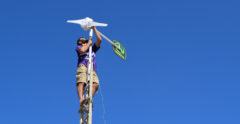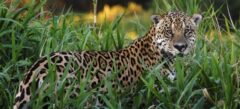
Virtually undiscovered by tourism, Guyana is the only country on the South American mainland where English is the first language, and cricket the first sport.
The Caribbean coast is a low-lying tangle of mangroves and Demerara sugar cane plantations connected by canals. Inland is a landscape of savannah and rainforest, of ancient tablelands and waterfalls that spill sheer from the plateaux. In the backcountry lodges here, the few visitors are treated as guests rather than tourists. Whilst in the south, the wildlife, so rarely disturbed, seems oblivious to observers.
It was late afternoon in Georgetown on the eve of the Hindu festival, phagwa. Saris, rasta hats and muslim robes spilled out onto the street from thronging Stabroek market. Office workers lingered, their white shirts already stained with purple dye and covered in flour. School kids gathered on corners, armed with squeezy bottles. Cows roamed the grass verges. A game of rudimentary cricket was underway on the green near Quamina Street. And Queen Victoria surveyed the scene from the Courthouse, looking unimpressed at the mayhem.
Even outside Hindu festivals, Guyana feels neither like the Caribbean, with which she has built her political and economic bridges, nor South America, where she sits between Venezuela and Suriname. Neglected by the Spaniards, settled by the Dutch and stolen by the English, Guyana is about the size of Britain but with fewer people than Birmingham. Churches, temples, mosques and a tin roofed cathedral cater for its ethnically diverse population. Guyana’s main exports are sugar, and - as one driver joked - people. Given the country’s economic statistics, I could well believe it. Within a minute or two of take off from Georgetown airport all signs of human influence are gone and you are flying over jungle. You expect to see roads but instead there are chocolate rivers snaking through the unbroken rainforest. There is little evidence of the remaining, chiefly Amerindian, ten percent of the population until you arrive at Lethem, in the Rupununi savannah of southern Guyana.
The Rupununi is a land of big skies and empty plains, of hammocks, cowboys and ranches where dinner gongs still sound at meal times. If you’re a fearful flyer, you can reach the Rupununi by dirt road from Georgetown but no one seems to agree how long it will take. So, I boarded the scheduled prop plane service to Lethem, clasped my hands and held my breath for ninety minutes as we flew over Guyana’s incredible emptiness.
Duane de Freitas met me at Lethem. Born in Georgetown, educated in Carlisle and expelled, so he says, after going astray on a school trip to Morocco, he now runs Guyana’s largest and most remote beef cattle ranch, Dadanawa. I threw my pack into his four wheel drive and we rattled through Lethem, the passenger door hanging off. We paused for breakfast in what seemed like somebody’s private dining room, picked up some leaky barrels of fuel, his shotgun, a chicken, an unwanted pet anteater and drove for three hours over rutted savannah tracks to Dadanawa ranch.
"Welcome to the nineteenth century" slurred an inhabitant of Dadanawa, soon after my arrival at the ranch. We unwound on the veranda overlooking the plains, while the maids prepared a lunch of curried Dadanawa beef. With 140 square miles to roam, it’s no surprise that the ranch cattle are widely scattered. During a silent Rupununi afternoon you can go and watch the barefoot cowboys work the corral on horseback, or take a sturdy horse out yourself - if you can fit your feet into the tiny stirrups. Evenings are normally spent on the veranda again, dozing in a hammock or in conversation.
From these isolated reaches of southern Guyana, we sailed up the Rupununi River and through the Kanuku Mountains to the pristine rainforests of the Maparri River. Duane had been preparing for this expedition for several weeks. When I arrived at Dadanawa, his sons had already left for the river with the boats, fuel and much of the supplies.
The Rupununi river floods its banks in the wet season and in the dry season the water can disappear from some sections leaving huge sandbanks and exposed rocks and branches. At all times it demands caution and concentration. In February, the water level was so low that paddles were used as much as the 15 Hp engines. We often got marooned on sandbanks and had to get out and push the boat back into deeper water, within sight of spectacled caimans and never knowing whether there might be a stingray underfoot. Now and then, a false alarm would send a crew member leaping back into the boat to everyone’s amusement. The going was slow, but the wildlife was more than enough reward. Kingfishers darted between the banks, oblivious to our presence. Scarlet macaws broke the silence as they screeched overhead. A howler monkey eyed us from a tree. Freshwater turtles plopped off the sandbanks into the river, and giant otters swam between the shores, their heads exposed.
On the second evening, we arrived at an unpromising looking camping spot at the mouth of the Maparri River. The vegetation on the riverbank looked so impenetrable that I wondered how on earth ten people would spend the night there. I stood, failing to look useful, while all around me a frenzy of machete blows turned what had looked like a complete non-starter into an established camp site. Within an hour, the kitchen was up and running, hammocks slung under mosquito nets, and a sit down meal was served. At dusk, a foot long awarana fish had leapt into the boat and ended up thrashing under my feet. Now it would be dinner, served fried, with vegetables and washed down with rum punch. We slept soundly in our hammocks that night.
The next six miles were the slowest yet. Three hours of ducking under fallen trees, unloading and hauling the boat over obstacles that would put off almost anyone from settling along the Maparri’s fortress-like banks. But it was a small price to pay for a taste of Eden. We interrupted a tapir taking an early morning drink and a flock of cormorants led the way upstream. Morpho butterflies crossed our path and a Cook’s boa constrictor was straddled along an overhanging branch, swallowing its prey. Peccaries snorted unseen inside the jungle.
We camped on an island at the point we could go no further, where a series of rapids and clear water pools provided a cold but very welcome bath after two days without one. It was a beautiful, idyllic location. Whereas the Rupununi is greasy brown and full of caimans, the Maparri is fast flowing, clear and bracing because its source lies in the Kanuku Mountains.
By mid afternoon on the fourth day the rainforest had petered out and we were sailing on the savannah again, heralded by the jabiru storks sitting in the few trees that were visible. The river was slightly deeper, so Duane’s boat reached a heart stopping eight miles per hour. Voices came from the riverbank just after darkness took over. We had reached Karanambo, and the end of our expedition. Karanambo cattle ranch is as isolated as almost anywhere else on the Rupununi but after four days in the jungle it feels like civilisation. Diane McTurk, proprietress of Karanambo, and purveyor of the finest rum punch on the Rupununi, is a descendent of the original Scottish pioneers on the plains. She is never short of an anecdote and laughs a lot, making you feel immediately at home in a place that couldn’t be further from it.
Beyond, the Rupununi’s northern reaches break at the Pakaraima Mountains. Hidden among a wilderness of virtually impenetrable forest at their eastern flank are the most dramatic of Guyana’s unsung delights, the Kaieteur Falls. Unless you have a week to spare for the overland odyssey from Georgetown, you can only reach the falls by air. There are no souvenir stands, turnstiles or fenced-off walkways, because there are no crowds. You can stand beside the thunderous curtain of water and watch it plummet 741 feet into the misty Potaro Gorge below. The surrounding jungle provides undisturbed sanctuary to the rare Guianan cock-of-the-rock and the golden frog. I saw both during my brief morning’s visit.
Indeed, Guyana knows how to spoil its few visitors with a wealth of natural treasures. You should start planning your visit now, while nature still stands tall.
Tailor-made holidays
Flexible, custom-made holidays to Latin America created to match your exact requirements: our tailor-made itineraries are as unique as the clients for whom they are designed.
Design my tripPapagaio
Your edit for Latin American inspiration
Our exciting range of articles on Latin America explore everything from iconic destinations and lesser-known cultural gems to delicious traditional recipes. You’ll also find exclusive travel tips, first-hand client reviews and the chance to get your personal questions answered by our travel experts.
View Extraordinary Inspiration






































